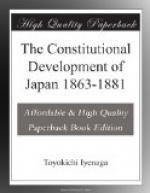Such, in brief, have been the changes in the industrial, social and religious condition of Japan from 1868 to 1881. After this study we shall not much wonder at the remarkable political change of Japan during the same period, which I shall endeavor to describe in the next chapter.
[Footnote 1: The American Commonwealth, Bryce, Vol. I., p. 7.]
[Footnote 2: A Survey of Financial Policy during Thirteen Years (1868-1880), by Count Okuma.]
[Footnotes 3, 4, 5: Count Okuma’s pamphlet.]
[Footnote 6: Consular Report of the U.S., No. 25, p. 182.]
CHAPTER V.
Progress of the constitutional movement from the abolition of feudalism to the proclamation of October 12, 1881.
The leaders of the Restoration were of an entirely different type from the court nobles of former days. They were, with a few exceptions, men of humble origin. They had raised themselves from obscurity to the highest places of the state by sheer force of native ability. They had studied much and travelled far. Their experiences were diverse; they had seen almost every phase of society. If they were now drinking the cup of glory, most of them had also tasted the bitterness of exile, imprisonment, and fear of death. Patriotic, sagacious, and daring, they combined the rare qualities of magnanimity and urbanity. If they looked with indifference upon private morality, they were keenly sensitive to the feeling of honor and to public morals. If they made mistakes and did not escape the charge of inconsistency in their policy, these venial faults were, for the most part, due to the rapidly changing conditions of the country. No other set of statesmen of Japan or of any other country, ancient or modern, have witnessed within their lifetime so many social and political transformations. They saw the days when feudalism flourished—the grandeur of its rulers, its antique chivalry, its stately etiquette, its ceremonial costumes, its codes of honor, its rigid social order, formal politeness, and measured courtesies. They also saw the days when all these were swept away and replaced by the simplicity and stir of modern life. They accordingly “have had to cast away every tradition, every habit, and every principle and mode of action with which even the youngest of them had to begin official life.”
The ranks of this noble body of statesmen and reformers are now gradually diminishing. Saigo and Gesho are no more. Kido and Iwakura have been borne to their graves. Okubo and Mori have fallen under the sword of fanatics. But, thanks be to God, many of them yet remain and bear the burdens of the day.
I have mentioned in Chapter III. the overthrow of feudalism and its causes. Its immediate effect on the nation, in unifying their thoughts, customs, and habits, was most remarkable. From this time we see the marked growth of common sentiment, common manners, common interest among the people, together with a love of peace and order.




